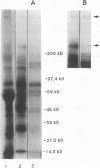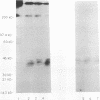Abstract
Cryptosporidium parvum causes acute diarrhea in immunocompetent individuals and a severe life-threatening disease in immunocompromised individuals, including AIDs patients. No efficacious therapy for cryptosporidiosis has yet been reported. However, treatment of some patients with cryptosporidiosis with hyperimmune bovine colostrum has ameliorated or eliminated clinical symptoms. Consequently, it is important to identify and characterize C. parvum antigens which are the targets of protective antibodies to facilitate the development of more efficacious therapy. We report that hyperimmune bovine colostral immunoglobulin inhibits C. parvum infectivity in a reproducible in vitro assay, and we correlate this inhibition with the protective capacity of the bovine colostrum in vivo. We have also identified the major C. parvum sporozoite antigens recognized on Western blots (immunoblots) by this colostral immunoglobulin preparation. Antibodies that recognize some surface molecules of other Apicomplexan parasites are protective in vivo. Consequently, we radioiodinated membrane proteins of sporozoites and immunoprecipitated 19 molecules which are the target of immunoglobulin that is protective in vivo and in vitro.
Full text
PDF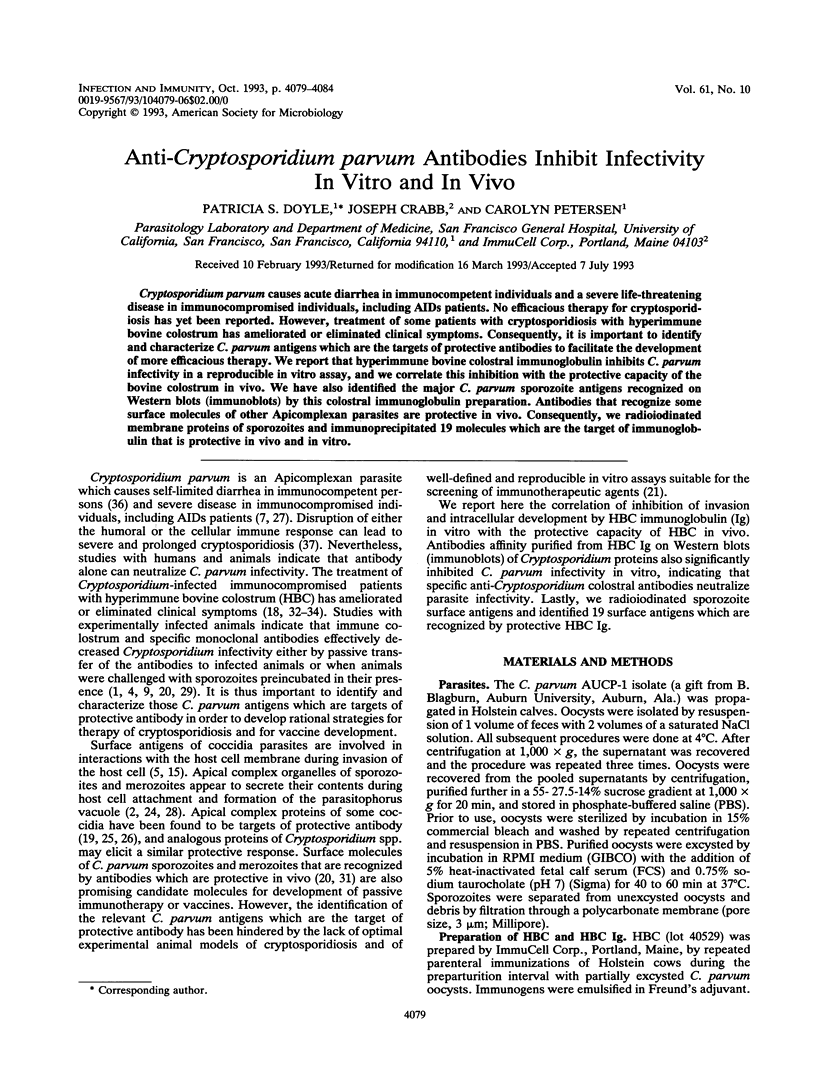
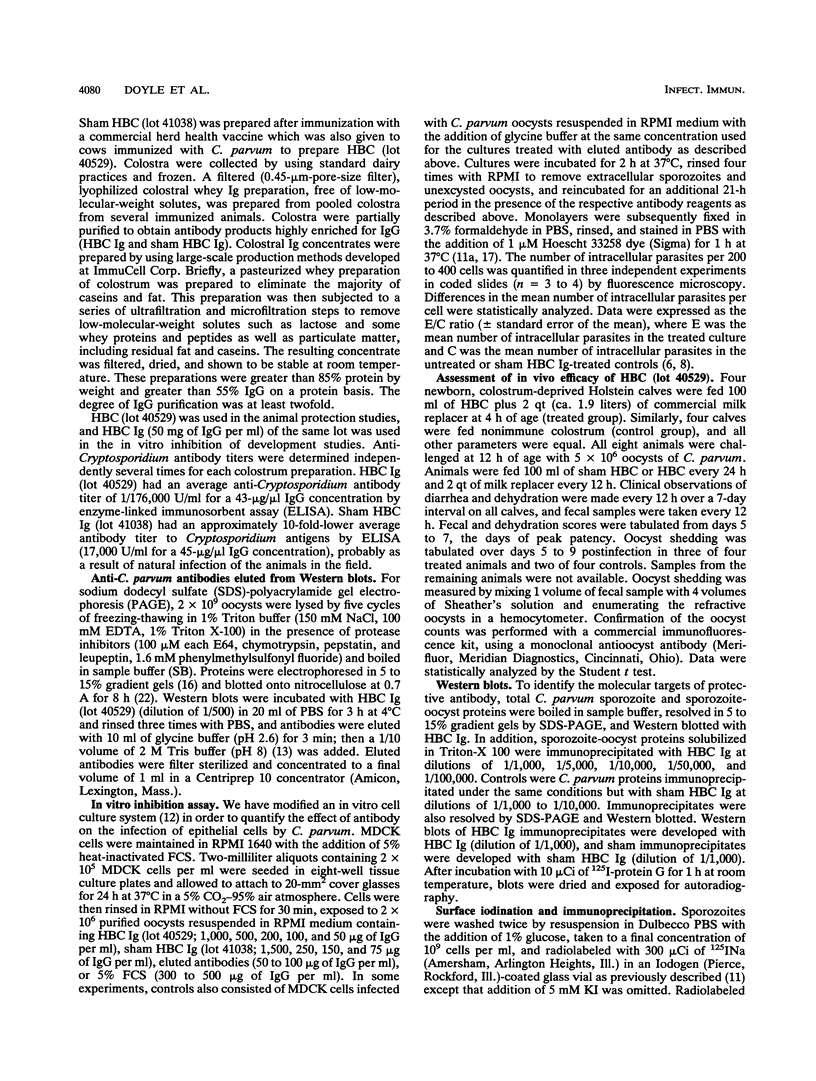
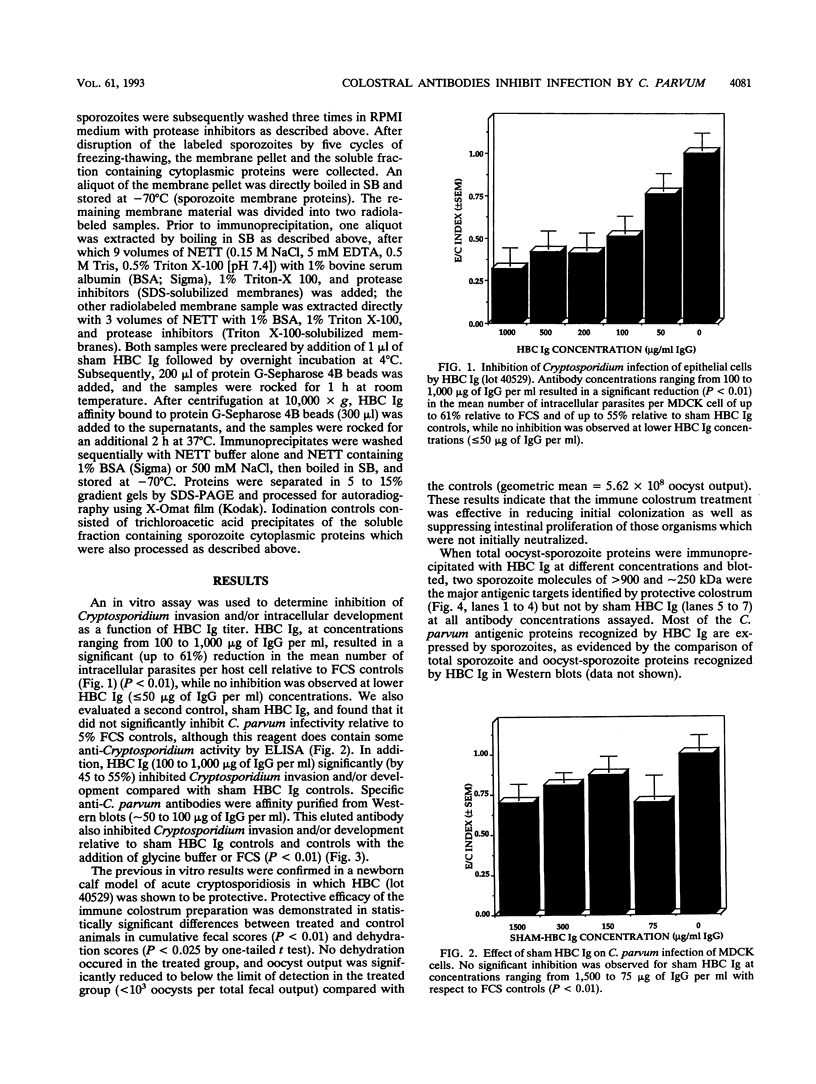
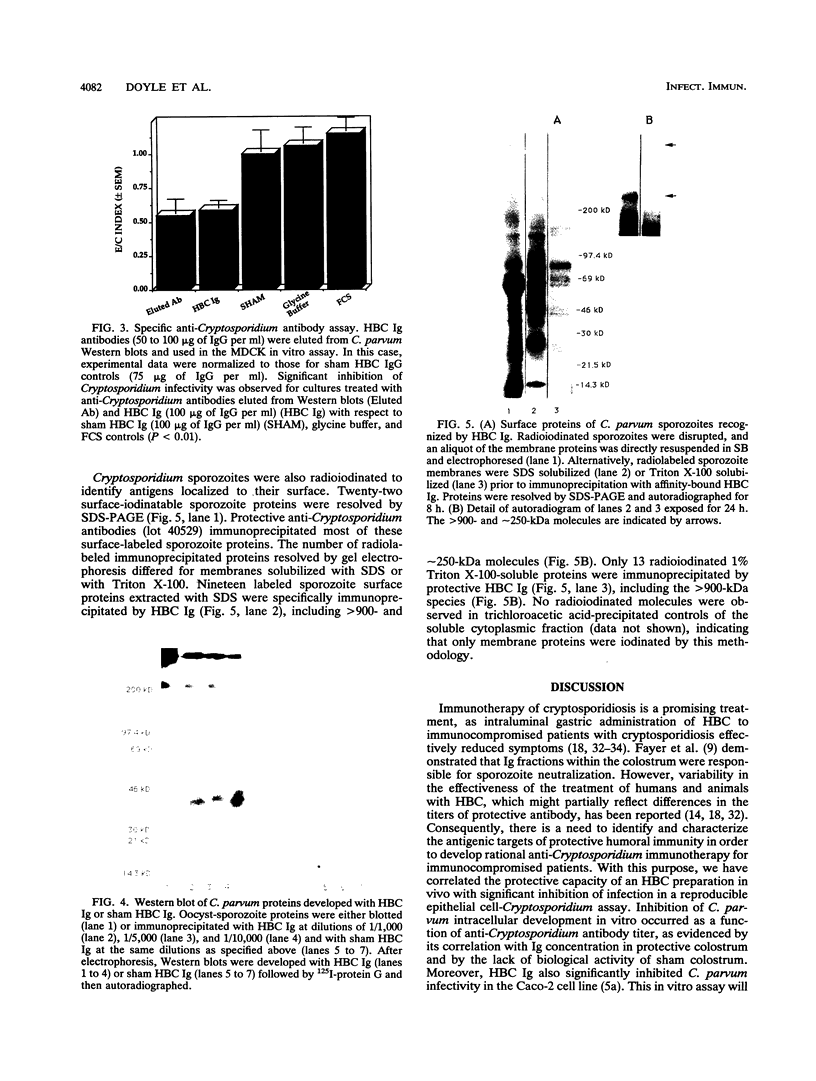
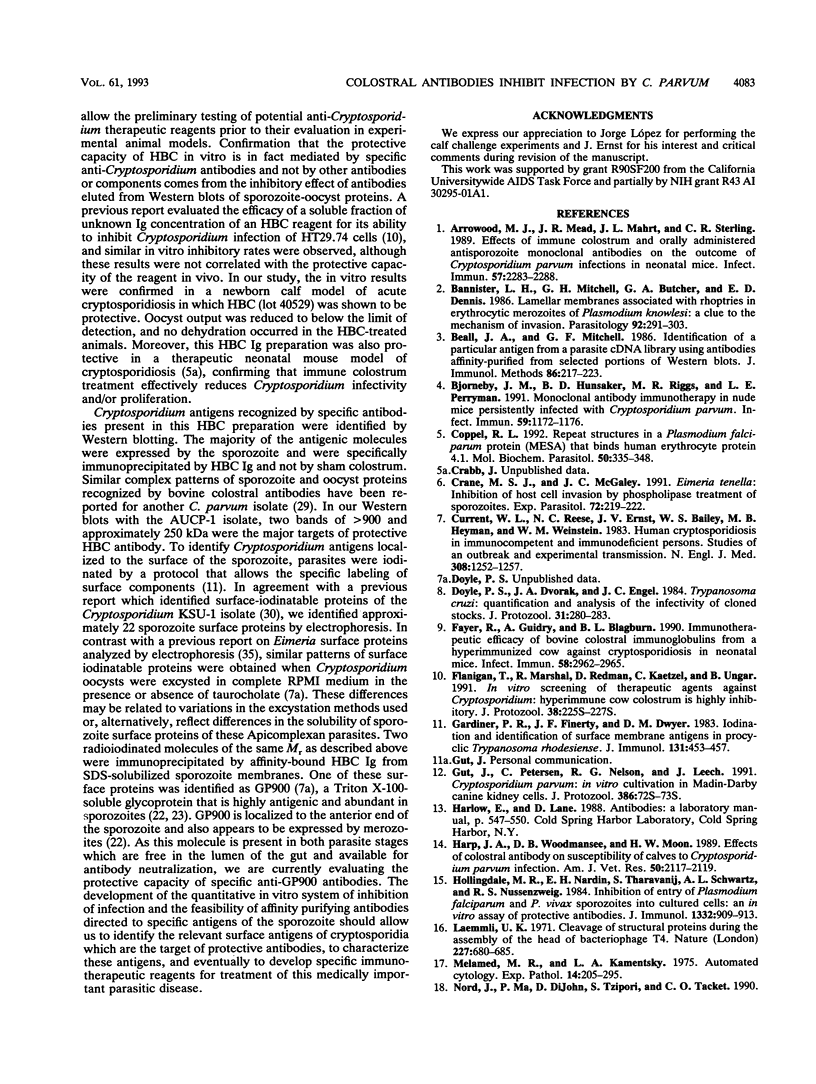
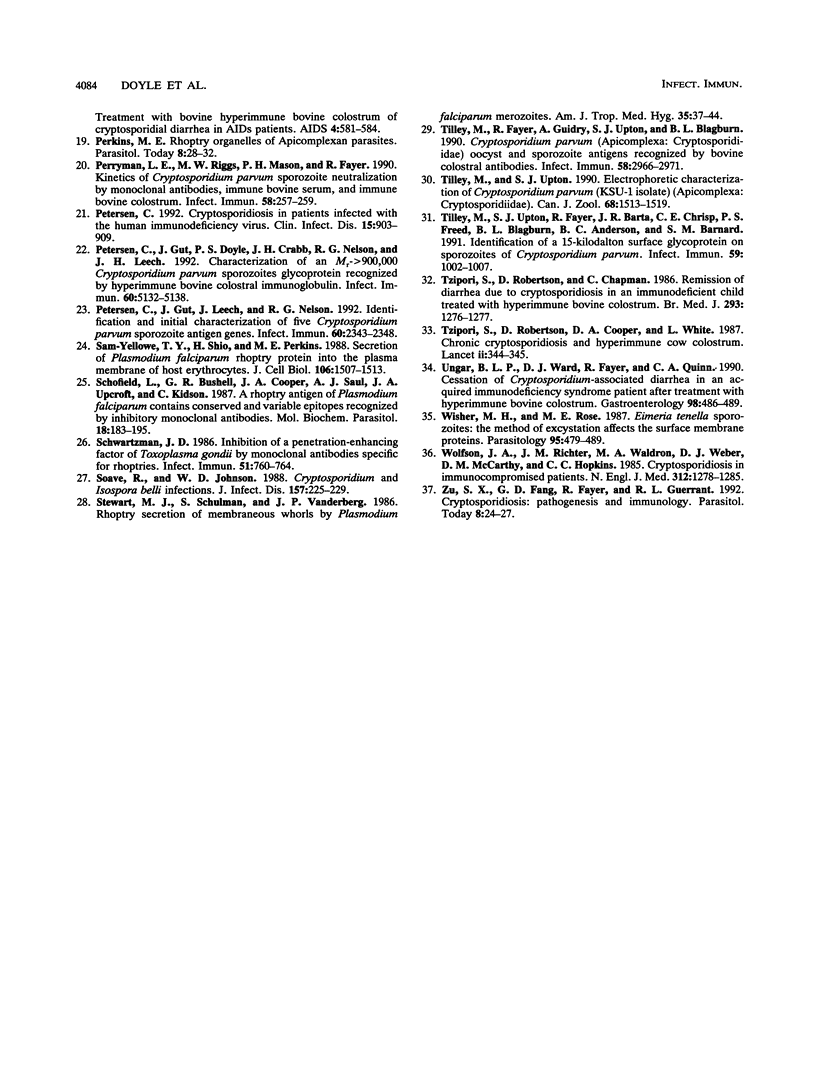
Images in this article
Selected References
These references are in PubMed. This may not be the complete list of references from this article.
- Arrowood M. J., Mead J. R., Mahrt J. L., Sterling C. R. Effects of immune colostrum and orally administered antisporozoite monoclonal antibodies on the outcome of Cryptosporidium parvum infections in neonatal mice. Infect Immun. 1989 Aug;57(8):2283–2288. doi: 10.1128/iai.57.8.2283-2288.1989. [DOI] [PMC free article] [PubMed] [Google Scholar]
- Bannister L. H., Mitchell G. H., Butcher G. A., Dennis E. D. Lamellar membranes associated with rhoptries in erythrocytic merozoites of Plasmodium knowlesi: a clue to the mechanism of invasion. Parasitology. 1986 Apr;92(Pt 2):291–303. doi: 10.1017/s0031182000064064. [DOI] [PubMed] [Google Scholar]
- Beall J. A., Mitchell G. F. Identification of a particular antigen from a parasite cDNA library using antibodies affinity purified from selected portions of Western blots. J Immunol Methods. 1986 Feb 12;86(2):217–223. doi: 10.1016/0022-1759(86)90456-4. [DOI] [PubMed] [Google Scholar]
- Bjorneby J. M., Hunsaker B. D., Riggs M. W., Perryman L. E. Monoclonal antibody immunotherapy in nude mice persistently infected with Cryptosporidium parvum. Infect Immun. 1991 Mar;59(3):1172–1176. doi: 10.1128/iai.59.3.1172-1176.1991. [DOI] [PMC free article] [PubMed] [Google Scholar]
- Coppel R. L. Repeat structures in a Plasmodium falciparum protein (MESA) that binds human erythrocyte protein 4.1. Mol Biochem Parasitol. 1992 Feb;50(2):335–347. doi: 10.1016/0166-6851(92)90231-8. [DOI] [PubMed] [Google Scholar]
- Crane M. S., McGaley C. J. Eimeria tenella: inhibition of host cell invasion by phospholipase treatment of sporozoites. Exp Parasitol. 1991 Feb;72(2):219–222. doi: 10.1016/0014-4894(91)90140-r. [DOI] [PubMed] [Google Scholar]
- Current W. L., Reese N. C., Ernst J. V., Bailey W. S., Heyman M. B., Weinstein W. M. Human cryptosporidiosis in immunocompetent and immunodeficient persons. Studies of an outbreak and experimental transmission. N Engl J Med. 1983 May 26;308(21):1252–1257. doi: 10.1056/NEJM198305263082102. [DOI] [PubMed] [Google Scholar]
- Doyle P. S., Dvorak J. A., Engel J. C. Trypanosoma cruzi: quantification and analysis of the infectivity of cloned stocks. J Protozool. 1984 May;31(2):280–283. doi: 10.1111/j.1550-7408.1984.tb02961.x. [DOI] [PubMed] [Google Scholar]
- Fayer R., Guidry A., Blagburn B. L. Immunotherapeutic efficacy of bovine colostral immunoglobulins from a hyperimmunized cow against cryptosporidiosis in neonatal mice. Infect Immun. 1990 Sep;58(9):2962–2965. doi: 10.1128/iai.58.9.2962-2965.1990. [DOI] [PMC free article] [PubMed] [Google Scholar]
- Flanigan T., Marshall R., Redman D., Kaetzel C., Ungar B. In vitro screening of therapeutic agents against Cryptosporidium: hyperimmune cow colostrum is highly inhibitory. J Protozool. 1991 Nov-Dec;38(6):225S–227S. [PubMed] [Google Scholar]
- Gardiner P. R., Finerty J. F., Dwyer D. M. Iodination and identification of surface membrane antigens in procyclic Trypanosoma rhodesiense. J Immunol. 1983 Jul;131(1):454–457. [PubMed] [Google Scholar]
- Gut J., Petersen C., Nelson R., Leech J. Cryptosporidium parvum: in vitro cultivation in Madin-Darby canine kidney cells. J Protozool. 1991 Nov-Dec;38(6):72S–73S. [PubMed] [Google Scholar]
- Harp J. A., Woodmansee D. B., Moon H. W. Effects of colostral antibody on susceptibility of calves to Cryptosporidium parvum infection. Am J Vet Res. 1989 Dec;50(12):2117–2119. [PubMed] [Google Scholar]
- Hollingdale M. R., Nardin E. H., Tharavanij S., Schwartz A. L., Nussenzweig R. S. Inhibition of entry of Plasmodium falciparum and P. vivax sporozoites into cultured cells; an in vitro assay of protective antibodies. J Immunol. 1984 Feb;132(2):909–913. [PubMed] [Google Scholar]
- Laemmli U. K. Cleavage of structural proteins during the assembly of the head of bacteriophage T4. Nature. 1970 Aug 15;227(5259):680–685. doi: 10.1038/227680a0. [DOI] [PubMed] [Google Scholar]
- Melamed M. R., Kamentsky L. A. Automated cytology. Int Rev Exp Pathol. 1975;14:205–295. [PubMed] [Google Scholar]
- Perryman L. E., Riggs M. W., Mason P. H., Fayer R. Kinetics of Cryptosporidium parvum sporozoite neutralization by monoclonal antibodies, immune bovine serum, and immune bovine colostrum. Infect Immun. 1990 Jan;58(1):257–259. doi: 10.1128/iai.58.1.257-259.1990. [DOI] [PMC free article] [PubMed] [Google Scholar]
- Petersen C. Cryptosporidiosis in patients infected with the human immunodeficiency virus. Clin Infect Dis. 1992 Dec;15(6):903–909. doi: 10.1093/clind/15.6.903. [DOI] [PubMed] [Google Scholar]
- Petersen C., Gut J., Doyle P. S., Crabb J. H., Nelson R. G., Leech J. H. Characterization of a > 900,000-M(r) Cryptosporidium parvum sporozoite glycoprotein recognized by protective hyperimmune bovine colostral immunoglobulin. Infect Immun. 1992 Dec;60(12):5132–5138. doi: 10.1128/iai.60.12.5132-5138.1992. [DOI] [PMC free article] [PubMed] [Google Scholar]
- Petersen C., Gut J., Leech J. H., Nelson R. G. Identification and initial characterization of five Cryptosporidium parvum sporozoite antigen genes. Infect Immun. 1992 Jun;60(6):2343–2348. doi: 10.1128/iai.60.6.2343-2348.1992. [DOI] [PMC free article] [PubMed] [Google Scholar]
- Sam-Yellowe T. Y., Shio H., Perkins M. E. Secretion of Plasmodium falciparum rhoptry protein into the plasma membrane of host erythrocytes. J Cell Biol. 1988 May;106(5):1507–1513. doi: 10.1083/jcb.106.5.1507. [DOI] [PMC free article] [PubMed] [Google Scholar]
- Schofield L., Bushell G. R., Cooper J. A., Saul A. J., Upcroft J. A., Kidson C. A rhoptry antigen of Plasmodium falciparum contains conserved and variable epitopes recognized by inhibitory monoclonal antibodies. Mol Biochem Parasitol. 1986 Feb;18(2):183–195. doi: 10.1016/0166-6851(86)90037-x. [DOI] [PubMed] [Google Scholar]
- Schwartzman J. D. Inhibition of a penetration-enhancing factor of Toxoplasma gondii by monoclonal antibodies specific for rhoptries. Infect Immun. 1986 Mar;51(3):760–764. doi: 10.1128/iai.51.3.760-764.1986. [DOI] [PMC free article] [PubMed] [Google Scholar]
- Soave R., Johnson W. D., Jr Cryptosporidium and Isospora belli infections. J Infect Dis. 1988 Feb;157(2):225–229. doi: 10.1093/infdis/157.2.225. [DOI] [PubMed] [Google Scholar]
- Stewart M. J., Schulman S., Vanderberg J. P. Rhoptry secretion of membranous whorls by Plasmodium falciparum merozoites. Am J Trop Med Hyg. 1986 Jan;35(1):37–44. doi: 10.4269/ajtmh.1986.35.37. [DOI] [PubMed] [Google Scholar]
- Tilley M., Fayer R., Guidry A., Upton S. J., Blagburn B. L. Cryptosporidium parvum (Apicomplexa: Cryptosporidiidae) oocyst and sporozoite antigens recognized by bovine colostral antibodies. Infect Immun. 1990 Sep;58(9):2966–2971. doi: 10.1128/iai.58.9.2966-2971.1990. [DOI] [PMC free article] [PubMed] [Google Scholar]
- Tilley M., Upton S. J., Fayer R., Barta J. R., Chrisp C. E., Freed P. S., Blagburn B. L., Anderson B. C., Barnard S. M. Identification of a 15-kilodalton surface glycoprotein on sporozoites of Cryptosporidium parvum. Infect Immun. 1991 Mar;59(3):1002–1007. doi: 10.1128/iai.59.3.1002-1007.1991. [DOI] [PMC free article] [PubMed] [Google Scholar]
- Tzipori S., Roberton D., Chapman C. Remission of diarrhoea due to cryptosporidiosis in an immunodeficient child treated with hyperimmune bovine colostrum. Br Med J (Clin Res Ed) 1986 Nov 15;293(6557):1276–1277. doi: 10.1136/bmj.293.6557.1276. [DOI] [PMC free article] [PubMed] [Google Scholar]
- Tzipori S., Roberton D., Cooper D. A., White L. Chronic cryptosporidial diarrhoea and hyperimmune cow colostrum. Lancet. 1987 Aug 8;2(8554):344–345. doi: 10.1016/s0140-6736(87)90944-5. [DOI] [PubMed] [Google Scholar]
- Ungar B. L., Ward D. J., Fayer R., Quinn C. A. Cessation of Cryptosporidium-associated diarrhea in an acquired immunodeficiency syndrome patient after treatment with hyperimmune bovine colostrum. Gastroenterology. 1990 Feb;98(2):486–489. doi: 10.1016/0016-5085(90)90842-o. [DOI] [PubMed] [Google Scholar]
- Wisher M. H., Rose M. E. Eimeria tenella sporozoites: the method of excystation affects the surface membrane proteins. Parasitology. 1987 Dec;95(Pt 3):479–489. doi: 10.1017/s0031182000057905. [DOI] [PubMed] [Google Scholar]
- Wolfson J. S., Richter J. M., Waldron M. A., Weber D. J., McCarthy D. M., Hopkins C. C. Cryptosporidiosis in immunocompetent patients. N Engl J Med. 1985 May 16;312(20):1278–1282. doi: 10.1056/NEJM198505163122002. [DOI] [PubMed] [Google Scholar]
- Zu S. X., Fang G. D., Fayer R., Guerrant R. L. Cryptosporidiosis: Pathogenesis and immunology. Parasitol Today. 1992 Jan;8(1):24–27. doi: 10.1016/0169-4758(92)90307-n. [DOI] [PubMed] [Google Scholar]



